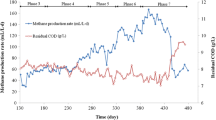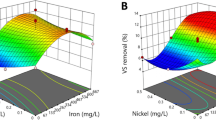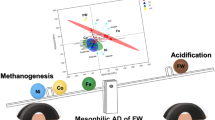Abstract
Anaerobic digestion (AD) of biodegradable organics depends heavily diverse functional genera, but an attempt to simultaneously enhance the various AD phases including the rate-limiting step (hydrolysis acidification) and methanogenesis has often remained a challenge. Although zero-valent iron (ZVI) supplementation had been proposed by many, its effect on the biomethanation process and microbial community evolution has not been fully explored. In this study, the response of hydrolysis acidification, methanogenesis, kinetics, pollutant removal efficiency, and microbial community evolution to various doses of ZVI employed in AD of food waste leachate was investigated and reported. When 10 g/L ZVI was dosed in the AD system, hydrolysis acidification, COD removal, biomethanation, and methane percentage were elevated by 18.9%, 67%, 39%, and 36%, respectively, as opposed to the control reactor (R1). Kinetics (R2 of 0.998) revealed shorter lag phase (ƛ = 4.18 days) in ZVI-dosed reactors in contrast to longer periods (6.54 days) in R1. Methane production rate constant (k), sludge activity, and methane production rate estimated were 0.066 (day−1), 0.83 gCH4/gVSS, and 64.20 mLCH4/gVSS/day, respectively, suggesting ZVI promoted methane production rate. Hydrolytic and methanogenic phyla including Firmicutes, Chloroflexi, Bacteroidetes, and Euryarchaeota were more enriched in ZVI-dosed reactors as opposed to R1. Acetoclastic-(Methanosaeta) and hydrogenotrophic-(Methanobacterium) methanogens were the most abundant genera of the archaea within ZVI-dosed assays, indicating acetoclastic methanogenesis was the main pathway.







Similar content being viewed by others
References
Altaş L (2009) Inhibitory effect of heavy metals on methane-producing anaerobic granular sludge. J Hazard Mater 162(2-3):1551–1556
Antwi P, Li J, Boadi PO, Meng J, Quashie FK, Wang X, Ren N, Buelna G (2017a) Efficiency of an upflow anaerobic sludge blanket reactor treating potato starch processing wastewater and related process kinetics, functional microbial community and sludge morphology. Bioresour Technol 239:105–116
Antwi P, Li J, Boadi PO, Meng J, Shi E, Xue C, Zhang Y, Ayivi F (2017b) Functional bacterial and archaeal diversity revealed by 16S rRNA gene pyrosequencing during potato starch processing wastewater treatment in an UASB. Bioresour Technol 235:348–357
Apha A (2005) WEF (2005) Standard methods for the examination of water and wastewater. Am Public Health Assoc Am Water Works Assoc Water Environ Fed
Ariunbaatar J, Panico A, Esposito G, Pirozzi F, Lens PN (2014) Pretreatment methods to enhance anaerobic digestion of organic solid waste. Appl Energy 123:143–156
Baek G, Kim J, Cho K, Bae H, Lee C (2015) The biostimulation of anaerobic digestion with (semi) conductive ferric oxides: their potential for enhanced biomethanation. Appl Microbiol Biotechnol 99(23):10355–10366
Barampouti E, Mai S, Vlyssides A (2005) Dynamic modeling of biogas production in an UASB reactor for potato processing wastewater treatment. Chem Eng J 106:53–58
Basu S, Oleszkiewicz J, Sparling R (2005) Effect of sulfidogenic and methanogenic inhibitors on reductive dehalogenation of 2-chlorophenol. Environ Technol 26(12):1383–1392
Bhattarai S, Kim DH, Oh J-H (2012) Simulation and model validation of a pneumatic conveying drying for wood dust particles. J Biosyst Eng 37(2):82–89
Budych-Gorzna M, Smoczynski M, Oleskowicz-Popiel P (2016) Enhancement of biogas production at the municipal wastewater treatment plant by co-digestion with poultry industry waste. Appl Energy 161:387–394
Corbellini V, Kougias PG, Treu L, Bassani I, Malpei F, Angelidaki I (2018) Hybrid biogas upgrading in a two-stage thermophilic reactor. Energy Convers Manag 168:1–10
Dong B, Xia Z, Sun J, Dai X, Chen X, Ni B-J (2019) The inhibitory impacts of nano-graphene oxide on methane production from waste activated sludge in anaerobic digestion. Sci Total Environ 646:1376–1384
Feng Y, Zhang Y, Quan X, Chen S (2014) Enhanced anaerobic digestion of waste activated sludge digestion by the addition of zero valent iron. Water Res 52:242–250
Fu S-F, Chen K-Q, Sun W-X, Zhu R, Zheng Y, Zou H (2018) Improved methane production of corn straw by the stimulation of calcium peroxide. Energy Convers Manag 164:36–41
Guan X, Sun Y, Qin H, Li J, Lo IM, He D, Dong H (2015) The limitations of applying zero-valent iron technology in contaminants sequestration and the corresponding countermeasures: the development in zero-valent iron technology in the last two decades (1994–2014). Water Res 75:224–248
Hao X, Wei J, van Loosdrecht MC, Cao D (2017) Analysing the mechanisms of sludge digestion enhanced by iron. Water Res 117:58–67
Hashemi SS, Karimi K, Mirmohamadsadeghi S (2019) Hydrothermal pretreatment of safflower straw to enhance biogas production. Energy. 172:545–554
Herlemann DP, Labrenz M, Jürgens K, Bertilsson S, Waniek JJ, Andersson AF (2011) Transitions in bacterial communities along the 2000 km salinity gradient of the Baltic Sea. ISME J 5(10):1571–1579
Hugerth LW, Wefer HA, Lundin S, Jakobsson HE, Lindberg M, Rodin S, Engstrand L, Andersson AF (2014) DegePrime, a program for degenerate primer design for broad-taxonomic-range PCR in microbial ecology studies. Appl Environ Microbiol 80(16):5116–5123
Hwang Y, Sivagurunathan P, Lee M-K, Yun Y-M, Song Y-C, Kim D-H (2019) Enhanced hydrogen fermentation by zero valent iron addition. Int J Hydrog Energy 44(6):3387–3394
Jiang Z, Lv L, Zhang W, Du Q, Pan B, Yang L, Zhang Q (2011) Nitrate reduction using nanosized zero-valent iron supported by polystyrene resins: role of surface functional groups. Water Res 45(6):2191–2198
Junyapoon S (2005) Use of zero-valent iron for wastewater treatment. Kmitl Sci Tech J 5(3):587–595
Li W, Khalid H, Zhu Z, Zhang R, Liu G, Chen C, Thorin E (2018) Methane production through anaerobic digestion: participation and digestion characteristics of cellulose, hemicellulose and lignin. Appl Energy 226:1219–1228
Li L, Kong X, Yang F, Li D, Yuan Z, Sun Y (2012) Biogas production potential and kinetics of microwave and conventional thermal pretreatment of grass. Appl Biochem Biotechnol 166(5):1183–1191
Liu Y, Wang Q, Zhang Y, Ni B-J (2015) Zero valent iron significantly enhances methane production from waste activated sludge by improving biochemical methane potential rather than hydrolysis rate. Sci Rep 5:8263
Negi S, Dhar H, Hussain A, Kumar S (2018) Biomethanation potential for co-digestion of municipal solid waste and rice straw: A batch study. Bioresour Technol 254:139–144
O'Shea R, Wall DM, Murphy JD (2017) An energy and greenhouse gas comparison of centralised biogas production with road haulage of pig slurry, and decentralised biogas production with biogas transportation in a low-pressure pipe network. Appl Energy 208:108–122
Park KY, Jang HM, Park M-R, Lee K, Kim D, Kim YM (2016) Combination of different substrates to improve anaerobic digestion of sewage sludge in a wastewater treatment plant. Int Biodeterior Biodegradation 109:73–77
Puyol D, Flores-Alsina X, Segura Y, Molina R, Padrino B, Fierro J, Gernaey KV, Melero JA, Martinez F (2018) Exploring the effects of ZVI addition on resource recovery in the anaerobic digestion process. Chem Eng J 335:703–711
Schnürer A, Nordberg Å (2008) Ammonia, a selective agent for methane production by syntrophic acetate oxidation at mesophilic temperature. Water Sci Technol 57(5):735–740
Sleiman N, Deluchat V, Wazne M, Mallet M, Courtin-Nomade A, Kazpard V, Baudu M (2016) Phosphate removal from aqueous solution using ZVI/sand bed reactor: Behavior and mechanism. Water Res 99:56–65
Velimirovic M, Schmid D, Wagner S, Micić V, von der Kammer F, Hofmann T (2016) Agar agar-stabilized milled zerovalent iron particles for in situ groundwater remediation. Sci Total Environ 563:713–723
Vivekanand V, Mulat DG, Eijsink VG, Horn SJ (2018) Synergistic effects of anaerobic co-digestion of whey, manure and fish ensilage. Bioresour Technol 249:35–41
Vyrides I, Andronikou M, Kyprianou A, Modic A, Filippeti A, Yiakoumis C, Samanides CG (2018) CO2 conversion to CH4 using zero valent iron (ZVI) and anaerobic granular sludge: Optimum batch conditions and microbial pathways. J CO2 Util 27:415–422
Walter A, Silberberger S, Juárez MF-D, Insam H, Franke-Whittle IH (2016) Biomethane potential of industrial paper wastes and investigation of the methanogenic communities involved. Biotechnol Biofuels 9(1):21
Wei W, Cai Z, Fu J, Xie G-J, Li A, Zhou X, Ni B-J, Wang D, Wang Q (2018) Zero valent iron enhances methane production from primary sludge in anaerobic digestion. Chem Eng J 351:1159–1165
Wu D, Zheng S, Ding A, Sun G, Yang M (2015) Performance of a zero valent iron-based anaerobic system in swine wastewater treatment. J Hazard Mater 286:1–6
Yin Q, Yang S, Wang Z, Xing L, Wu G (2018) Clarifying electron transfer and metagenomic analysis of microbial community in the methane production process with the addition of ferroferric oxide. Chem Eng J 333:216–225
Yuan L, Qi A, Cheng Y, Sagen G, Qu Y, Liu B (2017) Fecal microbiota of three bactrian camels (Camelus ferus and Camelus bactrianus) in China by high throughput sequencing of the V3-V4 region of the 16S rRNA gene. J Arid Land 9(1):153–159
Zhang H, Zhang P, Ye J, Wu Y, Fang W, Gou X, Zeng G (2016) Improvement of methane production from rice straw with rumen fluid pretreatment: a feasibility study. Int Biodeterior Biodegradation 113:9–16
Zhao Z, Zhang Y, Li Y, Quan X, Zhao Z (2018) Comparing the mechanisms of ZVI and Fe3O4 for promoting waste-activated sludge digestion. Water Res 144:126–133
Zhao Z, Zhang Y, Quan X, Zhao H (2016) Evaluation on direct interspecies electron transfer in anaerobic sludge digestion of microbial electrolysis cell. Bioresour Technol 200:235–244
Zhen G, Lu X, Li Y-Y, Liu Y, Zhao Y (2015) Influence of zero valent scrap iron (ZVSI) supply on methane production from waste activated sludge. Chem Eng J 263:461–470
Funding
This research was funded by the Natural Science Foundation of Jiangxi Province, China (Grant Number 20202BAB203019), the Scientific Research Start-up Fund of Jiangxi University Science and Technology-China (Grant Number JXXJBS18033), and the National Natural Science Foundation of China (Grant Number 51464014). The authors are much grateful to these institutions and all individuals who contributed to the success of this research.
Author information
Authors and Affiliations
Corresponding author
Additional information
Publisher’s Note
Springer Nature remains neutral with regard to jurisdictional claims in published maps and institutional affiliations.
Rights and permissions
About this article
Cite this article
Antwi, P., Zhang, D., Luo, W. et al. Response of hydrolysis, methanogenesis, and microbial community structure to iron dose during anaerobic digestion of food waste leachate. Biomass Conv. Bioref. 12, 5959–5973 (2022). https://doi.org/10.1007/s13399-020-00996-4
Received:
Revised:
Accepted:
Published:
Issue Date:
DOI: https://doi.org/10.1007/s13399-020-00996-4




